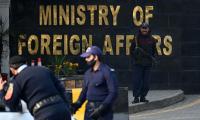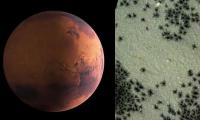Petrol prices were increased on July 15 in Pakistan by Rs5.40/litre to a level of Rs118/litre, while diesel prices were raised by Rs2.54/litre to a level of Rs116.53/litre.
In dollar terms, petrol and diesel prices have come down over the last 4-5 months, although international prices have increased over this period. On February 15, Pakistan’s petrol prices were $0.729/litre and Diesel $0.703/litre. On July 12, prices came down to $0.707/litre for petrol and $0.715/litre for diesel.
The current increases of Rs5.40 and Rs2.54 in petrol and diesel prices have kept the price dynamics the same. However international oil prices have been projected to decline in the short-to-medium terms affecting local prices as well, as will be discussed in this space later.
The lower income group is protesting, as they earn in rupees and not in dollars. It is due to the exchange rate depreciation in Pakistan that petrol and diesel prices appear to be high. Otherwise, Pakistani prices have been and still are on the lower side. Even when compared with Bangladesh, petrol prices there are 49 percent higher and diesel prices 7 percent higher. In Srilanka, petrol prices are 31 percent higher. However, diesel prices in Sri Lanka are 78 percent that of Pakistan – 22 percent lower than of Pakistan.
Pakistan’s exchange rate on July 15 was Rs159 to one dollar and India Rs74.55. Thus, the Indian rupee converts to PKR2.13. In India, petrol prices are Rs101.7 (Kolkata) and Rs107.5 (Mumbai). Diesel prices in Kolkata are INR101.7 and Mumbai INR107.5. Thus, in India petrol prices are 96 percent higher than Pakistan and diesel prices are 76 percent higher.
In India, petrol and diesel prices are changed daily and prices are different in different cities and regions. We have quoted the low-price regions’ prices. Also, more than 90 percent of the petroleum market in India is handled by three public-sector companies. However, despite the unregulated pricing regime, prices remain comparable among companies.
Fuel prices in India differ from state to state depending on the incidence of local taxes such as value-added tax (VAT) and freight charges. As much as 55 percent of the retail selling price of petrol in Delhi is made up of taxes. Half of the diesel price is made up of taxes. It should be noted that in Delhi energy prices and taxes are the lowest in India. In India, VAT on petroleum is charged by the states. It is hoped that this data does not initiate another controversy in Pakistan on federal vs provinces revenue sharing. Provinces do get a share in GST in Pakistan as per population formula. In Pakistan, petroleum levy is charged. Normal (maximum) rate is PKR30.00 per liter. It is adjusted according to price – higher PL at lower prices and lower PL at higher prices. Currently, no PLD is being charged to contain the impact of inflation on the people and the economy in general.
Internationally, oil pricing policies can be classified in four categories: lowest prices in oil-exporting countries of the Middle East; low oil price countries between lowest and US benchmark prices; above US benchmark and below highest price countries in Europe; highest price countries like Norway, Sweden etc, with relatively moderate prices and taxation. American oil prices are taken as a benchmark as these are stable and least taxed among developed countries and market economies. The current diesel price in the US is $0.862 and petrol price $0.922. Pakistan’s prices used to be in Category III but now it is under Category II of low prices.
Another general trend in pricing policies has been that diesel is almost universally taxed less than petrol. The argument has been that diesel is used in public and goods transport and has welfare and competitiveness implications. In Pakistan also, this used to be the case. There is a need to reconsider this policy in Pakistan. Admittedly, the political impact of increase in Petrol price is direct and immediate but within no time the impact of diesel prices results in consumer prices of commodities causing inflation.
The combined consumption of petrol and diesel in Pakistan is around 16 million tons or 200 billion liters. A one rupee per liter tax earns the government Rs200 billion. As compared to electricity, a Re1 per kWh increase in electricity price has an impact of Rs100 billion or slightly higher. The government has been reducing petroleum levy as international prices increased. It would have been politically impossible to charge the usual rate of Rs30 per liter although budgetary estimates have assumed Rs30 per liter. Continuous pressure on international oil prices will cause price inflation in Pakistan. The IMF keeps asking to charge higher taxation.
On July 15, oil prices (Brent) sank one percent on anticipated crude supply increase. The Brent crude oil price averaged $73/b in June 2021, up $5/b from May. June was the first month when the Brent price averaged more than $70/b since May 2019. In Q2 2020, Brent oil prices dipped briefly to $30/b from $50/b in Q1. From then on, oil prices kept increasing and have peaked to $75/b by mid-2021. The forecast is that oil prices will slide down continuously in the 3Q and 4Q of 2021 to slightly under $70/b and the downturn would continue in 2022 to reach $65/b by 4Q 2022 or even slightly lesser.
A major development and trend in international oil trade has been emerging which will have a significant impact on the oil price-demand equation. China’s oil imports have declined in the last half of 2021(1H 2021) for the first time in eight years. China has been the world’s largest importer of oil since 2013, replacing the US as the highest oil importer. Its imports have been in the range of 10-14 million barrels per day. Lower GDP projections and changes in energy policies in China have been attributed to decline in China’s oil imports and consumption. This confirms the EIA projections for a declining trend in oil prices.
It appears that the worst in terms of short-to-medium term oil prices has gone, and easier days are coming for the government and the people of Pakistan.
The writer is a former member of the Energy Planning Commission and author of ‘Pakistan’s Energy Issues:
Success and Challenges’.
Email: akhtarali1949@gmail.com
A representational image showing residents walking at a wholesale market in Karachi. — AFP/FileOnce again there is...
A representational image showing late Pakistani human rights activist and Supreme Court lawyer Asma Jahangir. —...
A representational image showing a security personnel sanding guard beside a ship carrying containers at Gwadar port....
A health worker administers polio vaccine drops to a child during a door-to-door polio vaccination campaign in Lahore,...
Armed militants of the banned Tehreek-e-Taliban Pakistan pose for a photograph in Orakzai Agency. —...
An aeroplane of the national flag carrier of Pakistan is seen in this file photo. — AFPWhile Pakistan considers...







